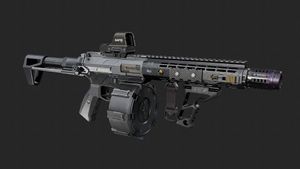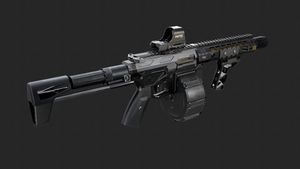No edit summary |
m (Cyclops moved page Mark XIIJ Raptr Shotgun to Mark 12J Raptr Shotgun) |
||
| (One intermediate revision by the same user not shown) | |||
| Line 1: | Line 1: | ||
[[File:raptr-shotgun-1.jpg|thumb]] | {{DEFAULTSORT:Raptr Shotgun, Mark 12J}}[[File:raptr-shotgun-1.jpg|thumb]] | ||
[[File:raptr-shotgun-2.jpg|thumb]] | [[File:raptr-shotgun-2.jpg|thumb]] | ||
The Mark 12 Raptr was developed by [[Cammunition Limited]] a defense contractor and weapons development firm based out of the Cardassian Union, founded after the fall of the military government at the end of the Dominion War. The weapon is designed as a modern successor to older shotgun designs still in use by Earth-based and some [[Federation]] personnel. | The Mark 12 Raptr was developed by [[Cammunition Limited]] a defense contractor and weapons development firm based out of the Cardassian Union, founded after the fall of the military government at the end of the Dominion War. The weapon is designed as a modern successor to older shotgun designs still in use by Earth-based and some [[Federation]] personnel. | ||
Latest revision as of 01:24, 16 June 2023


The Mark 12 Raptr was developed by Cammunition Limited a defense contractor and weapons development firm based out of the Cardassian Union, founded after the fall of the military government at the end of the Dominion War. The weapon is designed as a modern successor to older shotgun designs still in use by Earth-based and some Federation personnel.
The weapon is equipped with its own high resolution sensor pallet which can be used to relay information to a HUD or provide information via it's own multi-function display (located on the top of the weapon). This can calculate dispersal radius and effective range of various shell payloads and damage potential. The weapons cartridge can hold 20 standard 12-gauge shells of up to 7.62cm long. Internally it is powered by a high density plasmatic battery as their power source. These devices have the advantage of being completely rechargeable, able to use the EPS of most facilities.
Firing Mechanisms
In an effort to be more versatile the weapon is equipped with a number of propulsion methods.
- Standard Firing Pin / Primer Ignition
- The standard method of using a firing pin impacting a primer as method for igniting gunpowder or other explosive propellant charges.
- Inductive Charge Propulsion
- Advanced shells that receive a highly focused conductive charge via the barrel and use that to power some form of internal propulsion.
- Magnetic Mass Propulsion
- Similar to a rail gun, high energy opposing magnetic fields are used to propel a high mass slug at 5-8 times the speed of sound.
- Laser Ablation Propulsion
- A powerful high energy laser is used to heat and ionize the end of the cartridge using the explosive force of the materials statechange from solid to ionized gas.
Ammunition Types
- Standard 12-Gauge Shells
- HE Shells /w Variable Detonator
- These shells can be configured to detonate on impact or have a delayed time or proximity detonation.
- Plasma Incendiary Shells /w Proximity Detonator
- Designed to engulf a target in super heated plasma, set to detonate the moment before impact for maximum area of effect.
- Thermite Incendiary Shells
- Designed to burn through solid materials such as doors, bulkheads, or even rocks upon impact. These can also be effectively used to breech heavy armor.
- High Mass Slugs
- Lead, Depleted Uranium, or any number of other highly dense compounds formed into slugs. Most common slug materials are Iridium or Osmium.
- Slug / Plasma Hybrid
- Super heated plasma detonates around a highly dense metallic core effective just before impacting a target.